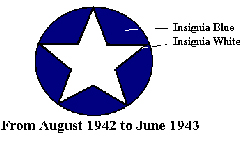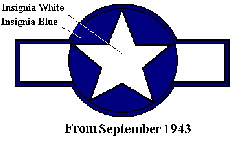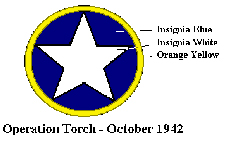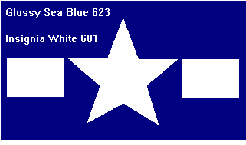

United States Aircraft National Insignia
US National
insignia and placement changed considerably from 1939 to 1945. From 1925 to 1939, US
aircraft wore bright, easily recognizable paint schemes, and were beyond doubt the easiest
aircraft to recognize in the air. The US national insignia at this time consisted of a
circle with a 5 point star and red roundel in the center of the star. The USAAF prescribed Spec. 3-1 Flag Blue # 24, FS# 15044. The
Navy utilized ANA Insignia Blue 605. This color was adopted in 1943 as the ANA standard. The white star was Insignia White 601, and the
red roundel in the center of the star was (Figure 1).
Prior to February of 1941, roundels were applied to both upper wing
surfaces, underwing surfaces, and fuselage sides.
In February of 1941, all bright squadron and section markings were
ordered removed, the right upper and left underside roundels removed, and rudders painted
with alternating red and white stripes (Fig. 2).
In January of 1942, roundels were again applied to all 4 wing
positions. The use of Flag Red # 15 (FS#11105) was dropped in favor of Insignia Red ANA
618, an RAF color, in January 1942. The RAF
red was considerably more subdued, as was better suited to camouflage schemes. Four months
later, on May 12th, 1942, the red center of the national insignia was ordered removed from
all combat aircraft (Fig. 3), as were the rudder stripes. Two weeks later, Spec. 98-24102
ordered the red center of the national insignia removed from all aircraft.
Figure 1. |
Figure 2. |
|
|
| Figure 3. | Figure 4. |
 |
|
In February of 1943, orders again
called for the removal of the right upper and left lower wing roundels. This was realized by combat pilots, who were often
reacting to shapes and positions of national markings rather than colors. Japan utilized hinomarus on both upper wing
surfaces, and from a distance, two circles on both upper wing surfaces often caused
considerable tension, even when white stars were present.
This did not provide a viable solution to the problem, so in June of 1943,
bars were added with an Insignia Red 618 border (Fig.4).
In September, Insignia Blue 605 replaced the
red border (Fig. 5). This remained the
standard insignia throughout the remainder of the war.
| Figure 5. | Figure 6. |
 |
 |
Several
variations to the national insignia existed, including the standard late June 1942 roundel
with a yellow surround. This
“temporary” roundel was carried by aircraft operating in North Africa during
Operation Torch, August-September 1942. Another
Variation to the U.S. national insignia occurred late in the war, and was not official
practice. In March 1944, the US Navy
ordered fighter aircraft painted overall Glossy Sea Blue 623. By October 1944 the rule applied to all
carrier based fighter, torpedo, and bomber aircraft. Due to the similarities between
Insignia Blue 605 (FS#35044) and Glossy Sea Blue 623 (FS#15042), Insignia Blue was often deleted in national
insignia. The result was a white star and two white bars with no apparent circular
surround (Fig.7). The practice was quite
common, however, its use was not officially recognized until June 1946, when the Navy
authorized the blue background and border could be deleted on aircraft painted overall
Glossy Sea Blue 623 or Black 604.
Figure 7.
